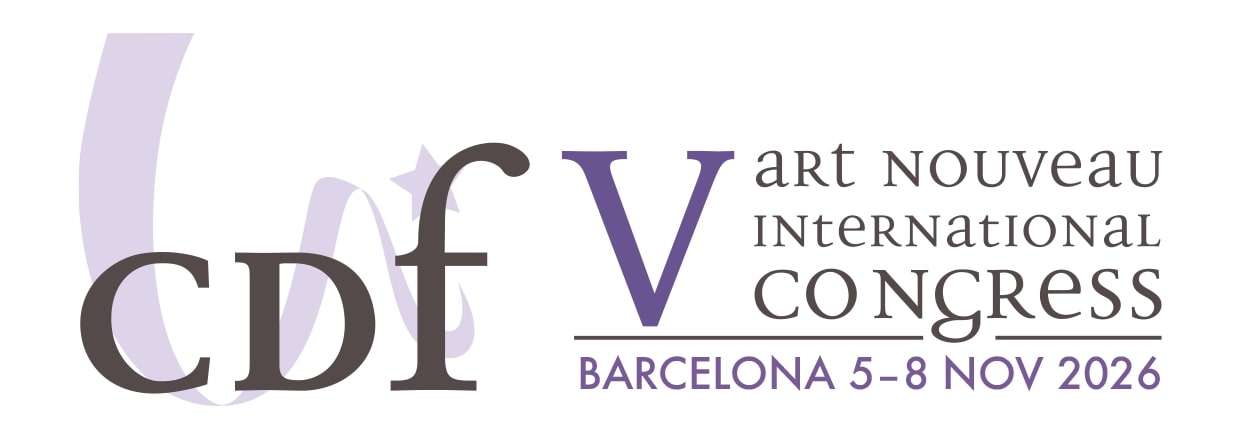Exhibition: Camille Martin (1861-1898): A Feeling for Nature
From 26.03.2010 to 29.08.2010
Nancy
www.ecole-de-nancy.com
Organised by Musée de l´École de Nancy
Exhibition: De Gaudí a Picasso
From 15.03.2010 to 27.06.2010
Valencia
www.ivam.es
Organised by Instituto Valenciano de Arte Moderno
Exhibition: Art Nouveau and Luxury Goods in France
From 15.09.2009 to 13.06.2010
Paris
www.musee-orsay.fr
Organised by Musée d'Orsay
Art Nouveau presents itself with good reason as breaking with the styles of the past, and promoting a "modern" environment based on a revival of forms and decorations. From the point of view of work produced, on the other hand, and this in spite of its social aspirations, it belongs to the tradition of the often-expensive technical experiments that brought fame to the luxury goods industries in France throughout the 19th century and until the early 20th century.
The objects as well as the preparatory drawings presented in this exhibition are evidence of the sophistication that French manufactories and creative artists brought to the art of living.
Meeting: Hobbies in Barcelona in 1900
From 23.03.2010 to 25.05.2010
Barcelona
www.amatller.com
Organised by Casa Amatller
Exhibition: Joseph Maria Olbrich 1867-1908, Architect and Creator of Early Modernity
From 07.02.2010 to 24.05.2010
Darmstadt
www.mathildenhoehe.eu
Organised by CoupDefouet

The latest research carried out by the Mathildenhöhe Institute-Darmstadt is the result of a comprehensive retrospective on the work of Joseph Maria Olbrich to be inaugurated in Darmstadt at the beginning of February 2010. The exhibition, entitled Joseph Maria Olbrich 1867-1908, Architect and Creator of Early Modernity, is being curated by Dr. Regina Stephan, professor of the history of architecture at the Mainz University of Applied Sciences, in collaboration with Vienna's Leopold Museum.
Experts on Olbrich's work consider him to be the great moderniser of the world and lifestyles, but his premature death and the destruction of many of his works during the Second World War meant that his output has perhaps not had the same international impact as other artists of his age, such as Henry van de Velde, Josef Hoffmann or Peter Behrens. This is why the instigators of the exhibition and catalogue aim to provide the general public with information about the relevance of the artistic legacy that Joseph Maria Olbrich left around 1900 in Darmstadt and other cities like Vienna or in the Rhineland.
This major retrospective has been made possible thanks to the latest research that has been carried out on this great architect and designer based on the interest created during the international conferences organised by Mathildenhöhe-Darmstadt on the occasion of the centenary of J. M. Olbrich's death (see coupDefouet nº 11). The exhibition includes reconstructions of Olbrich's projects through the use of original sketches, models, historical photographs and many objects from such diverse fields as graphic design, furniture, crafts and textile art.
The show can be visited from 7 February until 24 May 2010 at the Mathildenhöhe Institute-Darmstadt, with family days between 20 and 25 April, including a special games route for children on the 25th.
Exhibition: Tiffany Glass. A Passion for Colour
From 12.02.2010 to 02.05.2010
Montreal
www.mbam.qc.ca/fr/index.html
Organised by Musée des beaux-arts de Montréal
Exhibition: The modernista adventure in the MNAC's collections. Cartagena
From 17.02.2010 to 25.04.2010
Museo de Arte Regional de Arte Moderno in Cartagena
www.obrasocial.caixacatalunya.es
Organised by Obra Social Caixa Catalunya
The Social Work of Caixa Catalunya will transport you to one of the richest periods in the cultural and artistic history of Barcelona at the end of the 19th century, when the city became the privileged setting of modernisme.
The exhibition consists of 90 works of Catalan modernisme by Gaudí among others. The items, including paintings, sculptures, furniture and decorative art, all come from the collection of "Museu Nacional d'Art de Catalunya" (The National Art Museum of Catalonia).
Exhibition: Munch and Denmark
From 22.01.2010 to 18.04.2010
Oslo
www.munch.museum.no
Organised by Munch and Denmark
Exhibition: Vienna 1900. Leopold Collection
From 02.07.2009 to 31.03.2010
Vienna
www.leopoldmuseum.org
Organised by Leopold Museum
Exhibition: The Portrait Workshop, Rodin Faces his Models
From 04.12.2009 to 28.03.2010
Angers
www.musees.angers.fr
Organised by Les musées d’Angers
Exhibition: Designers of Hungarian Art Nouveau Furniture
From 07.02.2010 to 22.03.2010
Budapest
www.imm.hu
Organised by Zsolt Somogyi

The Museum of Applied Arts in Budapest presents "Lilies Sprung upon a Barren Rock": Hungarian Art Nouveau Furniture Designers, an exhibition on Art Nouveau furniture (1896-1914) beginning with Hungarian Art Nouveau and including the most important designers of Ödön Lechner's style. His designs for the museum's original furnishings can be seen, along with armchairs designed by Marcell Komor for the city hall of Subotica and outstanding furniture designs that Ödön Faragó created for Queen Elizabeth's "Garden Room" in Buda Castle.
Many Hungarian Art Nouveau designers were in tune with the New Style's international trends and works by Frigyes Spiegel, Pál Horti, József Rippl-Rónai or unknown Hungarian masters show the influence of French Art Nouveau, German Jugendstil, Viennese Secession and British Arts & Crafts. The museum also commemorates the Gödöll? Arts & Crafts Workshop, with its principal figures and followers - Ede Toroczkai Wigand, Aladár Körösf?i Kriesch, Béla Pálinkás or Károly Kós - committed to finding a "pure source", which they discovered by investigating folk art, thus a national style appeared more faithfully in their works than in Lechner's art.
The museum ends with the precursors of trends between the two World Wars, with late Art Nouveau designers preceding Art Deco and other modern movements, highlighted by the art of Béla Lajta, who designed the furniture for the Bard Music Store in Hungarian Art Nouveau style, chairs for the Institute of the Blind using forms from Hungarian folk art, and the Vas Street Trade School in his own style, which was already leaning towards Art Deco. Pieces by Lajos Kozma, József Vágó, Miklós Menyhért or Dénes Györgyi also show the characteristic features of late Art Nouveau.
The exhibition includes about 100 pieces of furniture from Hungarian and foreign museums and private collections, as well as 120 archival photos, plans and drawings.





